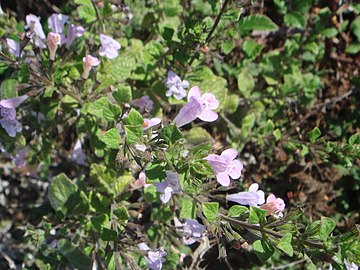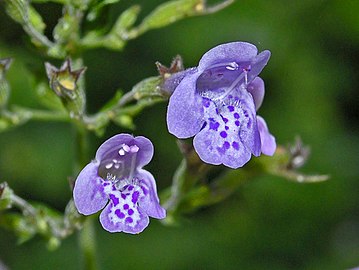Clinopodium menthifolium
| Clinopodium menthifolium | |
|---|---|

| |
| Scientific classification | |
| Kingdom: | Plantae |
| Clade: | Tracheophytes |
| Clade: | Angiosperms |
| Clade: | Eudicots |
| Clade: | Asterids |
| Order: | Lamiales |
| Family: | Lamiaceae |
| Genus: | Clinopodium |
| Species: | C. menthifolium
|
| Binomial name | |
| Clinopodium menthifolium | |
| Synonyms | |
| |
Clinopodium menthifolium, commonly known as the wood calamint or woodland calamint, is a species of flowering plant in the mint family, Lamiaceae. It is found throughout southern and central Europe from the United Kingdom and east as far as temperate parts of Asia, and as south as North Africa. It grows up to 1,700 m (5,600 ft) in elevation.[1]
The three subspecies of C. menthifolium have been previously considered separate species, including C. m. subsp. ascendens (syn. C. ascendens), the common calamint[2] or ascending wild basil,[3] and C. m. subsp. hirtum (C. hirtum).
Taxonomy
[edit]This section needs expansion. You can help by adding to it. (August 2020) |
The wood calamint was first formally named in 1831 by Nicolaus Thomas Host as Calamintha menthifolia.[4]
Three subspecies are accepted:[5]
- Clinopodium menthifolium subsp. menthifolium (Host) Stace – commonly called Calamintha sylvatica
- Clinopodium menthifolium subsp. ascendens (Jord.) Govaerts – commonly called Calamintha ascendens
- Clinopodium menthifolium subsp. hirtum (Briq.) Govaerts – commonly called Calamintha hirta
Description
[edit]Clinopodium menthifolium subsp. menthifolium is a tufted, hairy, mint-scented perennial herb with an upright habit and few branches. It grows to a height of around 60 cm (2 ft). The leaves are dark green, stalked and grow in opposite pairs. The leaf blades are ovate with rounded teeth and are larger than those C. menthifolium subsp. ascendens. The lipped flowers are also larger and darker, with the corolla lobe at least twice as long as the hairy calyx.[6]
Clinopodium menthifolium subsp. ascendens grows to about 30–60 millimetres (1.2–2.4 in) in height. This perennial rhizomatous herbaceous hemicryptophyte plant has stalked leaves and an erect hairy stem with tall flowering spikes. It produces pinkish or bluish flowers with spots on the white lower lip. They bloom from July to September.[7][8]
Distribution and habitat
[edit]Wood calamint is native to Western Europe and North Africa. Its range extends from France and Germany south to Spain and Algeria, and it also known from Northern Syria.[9] In Britain, it is limited to a single site in the Isle of Wight, where it grows in ancient deciduous woodland on a chalk soil.[10] It has been introduced into the United States where it has become naturalised in California and Virginia.[3]
Clinopodium menthifolium subsp. ascendens occurs on dry, calcareous soils in hedges, roadsides, grasslands and rocky grounds.[7][8]
Uses
[edit]The leaves of wood calamint can be infused to make an aromatic herb tea. They can also be added to cooked foods, imparting a pungent, aromatic flavour that has been described as being a combination of the flavours imparted by marjoram and mint.[9] The plant is also used as an ornamental for garden cultivation, and will attract butterflies and bees.[11]
The plant has also been used medicinally, as a diaphoretic and an expectorant, and to settle the stomach. It can be added to cough medicine, often in combination with yarrow (Achillea millefolium) and thyme (Thymus vulgaris). It is also used to treat fever, insomnia and depression.[9]
References
[edit]- ^ "Clinopodium menthifolium". Germplasm Resources Information Network. Agricultural Research Service, United States Department of Agriculture. 455252.
- ^ BSBI List 2007 (xls). Botanical Society of Britain and Ireland. Archived from the original (xls) on 2015-06-26. Retrieved 2014-10-17.
- ^ a b NRCS. "Clinopodium ascendens". PLANTS Database. United States Department of Agriculture (USDA). Retrieved 17 January 2016.
- ^ "Calamintha menthifolia Host". ipni.org. International Plant Names Index. Retrieved 23 August 2020.
- ^ "Clinopodium menthifolium (Host) Merino". Plants of the World Online. Royal Botanic Gardens, Kew. Retrieved 23 August 2020.
- ^ McClintock, David; Fitter, R.S.R. (1961). The Pocket Guide to Wild Flowers. London: Collins. p. 154.
- ^ a b Online Atlas of the British and Irish flora
- ^ a b Dorset Nature
- ^ a b c "Calamintha sylvatica - Bromf". Plants for a Future. Retrieved 5 April 2020.
- ^ "Rowridge Valley SSSI" (PDF). Natural England. Retrieved 5 April 2020.
- ^ "Calamintha sylvatica". GardensOnline. Retrieved 5 April 2020.


